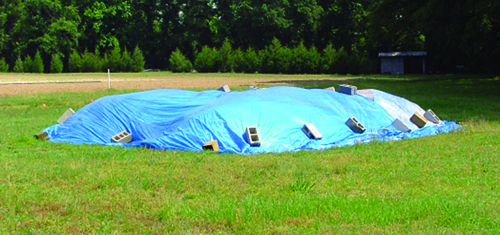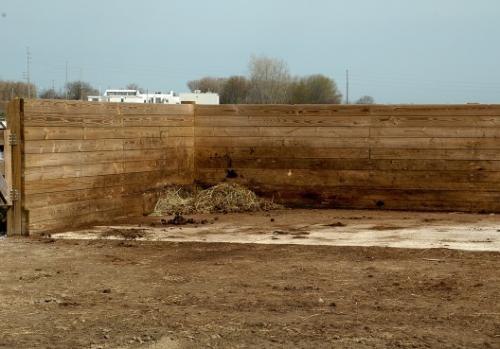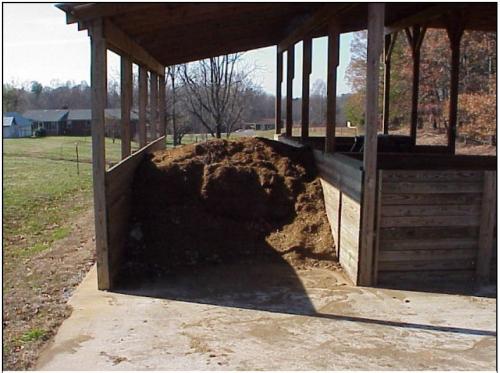Storing manure on small farms – deciding on a storage option
The capability to store manure reduces, or eliminates, the need to spread manure on a daily basis. Manure storage facilities allow small farms to store the manure until it can be removed and utilized at a later time.

Small farms can choose to spread or store manure. Most small livestock or horse farms are handling solid manures usually with some form of bedding – straw, wood shavings, sawdust, etc. Rather than collect the manure and bedding daily, load it in a spreader and spread it on cropland, hay land or pasture – farmers may choose to store the manure for a period of time when it can be spread, or hauled away, at a later time. Options for storage include: stockpiling, dry stack, composting, liquid storage or hauling away. The goal of proper manure storage on all farms should be to minimize nuisance issues (flies or aesthetics) and environmental impacts (water or air). Michigan State University Extension recommends that small farms keep in mind the following principles when planning or maintaining their manure storages.
Principles of Manure Storage
- Keep the clean water clean – divert rooftop or surface runoff away from manure storage.
- Treat the dirty water – use of vegetated filter strips.
- Store the manure out of a flood hazard area.
- Store the manure where it is easily accessible to load and unload.
- Avoid steep slopes when siting your storage location.
- Have a Nutrient Management Plan – if spreading manure on owned land.
Storing manure on small farms – Stockpiling

Figure 1: Use of a tarp to cover stockpile. Photo Taken by Virginia Cooperative Extension
Stockpiling manure is essentially piling the solid manure and soiled livestock or horse bedding in a convenient location. It is an acceptable method to store manure on small farms. The location of the pile must be compacted and sealed to prevent manure nutrients from leaching into the soil profile. Clay soils are an excellent base for piles as opposed to sandy soils which allow nutrients to leach through. The loading area should be firm to prevent rutting in wet periods (rainfall events or spring thaws). There should be a very slight slope (1-3 percent) to allow the pile to drain toward a vegetated filter strip. Using a plastic tarp to cover the stockpile will help to reduce odor and flies (Figure 1). It also reduces the concern for leaching as it prevents rainwater from contacting and soaking through the pile. Compared to all other storage methods, stockpiling is the lowest cost option.
Storing manure on small farms – Dry Stack

Figure 2: Dry stack with concrete floor and horizontal timber walls. Photo taken by USDA, NRCS
Dry stacking manure is the most common and most practical method of manure storage for small livestock or horse operations. The key components of a dry stack facility are the impervious floor and three walls used to contain the manure. A poured concrete floor is an excellent example of an impervious floor. The floor should be slightly sloped for drainage towards a vegetated filter strip. The walls of the facility should be a minimum of four feet high and small farm owners should consider the outward pressure on the walls from piled manure. The walls can be poured concrete, cinder block, horizontal or vertical timbers (Figure 2). It is also critical to secure anchoring for the facility below the frost line. The cost for this type of facility can be moderate.
Storing manure on small farms – Composting
Figure 3: An example of composting horse manure. Photo taken by USDA, NRCS
Composting manure and bedding on small farms is gaining in popularity. One of the reasons for this is that the “finished” product of composting is crumbly, low in odor and resembles rich topsoil. It is a highly marketable product, popular with gardeners and landscapers. Composting reduces the amount of available nutrients, kills pathogens, reduces the odor and reduces the volume of manure and bedding. Composting requires careful management in order to produce the final end product (Figure 3). An important management practice is tracking the temperature cycles of the compost piles. The center of the pile should reach 140 degrees Fahrenheit which kills the pathogens and renders a relatively stable product. When the compost pile is properly mixed, or aerated, the manure compost can turn into a finished product in as little as six weeks. The cost of this method of storage can be moderate to high depending on the complexity of the facility. Get additional information on composting manure from eXtension.
Storing manure on small farms – Liquid Storage
Liquid manure storage is used by many larger dairy or swine farms. Liquid manure is transferred or collected into a pit or lagoon structure. It may be mixed, pumped into manure spreading equipment and land applied. This form of manure storage is the most complex and expensive system. It is usually not practical for smaller livestock operations.
Storing manure on small farms – Hauling Away
When manure storage availability is limited on a small farm there are still options available for producers. If the manure generated daily on the farm is small enough utilizing a small manure spreader as storage may be the right option for some farms. When the spreader is full simply hook up the tractor and spread on cropland or hay land according to a Nutrient Management Plan. Another option may be to hire or contract with a certified manure hauler to come and remove the manure. Haulers may take the manure to a centralized composting facility or may spread the manure on farmland. It is important to remember that the manure will still need to be stored in between visits. The use of dumpsters, though expensive, may be a viable option when there is inadequate land for spreading or composting is not an option. Small farms may use dumpsters to store manure until it is removed. Dumpsters should be placed on an impervious surface such as concrete that may allow for collection of any liquids that leave the dumpster. The last option for small farms is to consider marketing the manure or the compost. Livestock or horse owners may sell or give their manure away (composted or non-composted) for off-farm use. Gardeners are frequently willing to take (or even buy) composted manures. Crop farmers may be willing to spread the manure on their land during certain times of the year.
Other articles in this series



 Print
Print Email
Email



